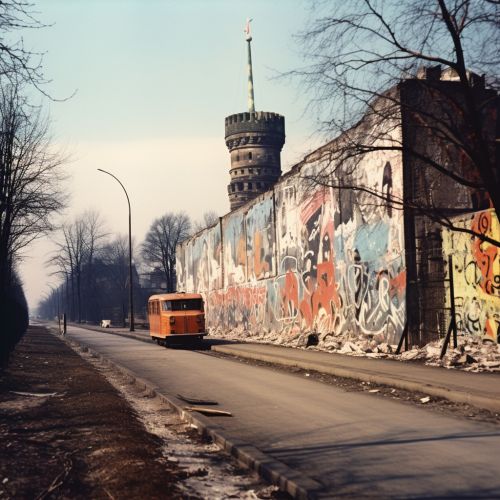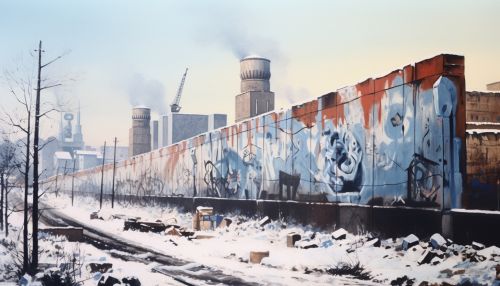Berlin Wall
History
The Berlin Wall was a guarded concrete barrier that physically and ideologically divided Berlin from 1961 to 1989. Constructed by the German Democratic Republic (GDR, East Germany), starting on 13 August 1961, the Wall cut off West Berlin from virtually all of surrounding East Germany and East Berlin until government officials opened it in November 1989. Its demolition officially began on 13 June 1990 and was completed in 1992.


Background
After the end of World War II in Europe, what remained of pre-war Germany west of the Oder-Neisse line was divided into four occupation zones (as per the Potsdam Agreement), each one controlled by one of the four occupying Allied powers: the United States, the United Kingdom, France and the Soviet Union. The capital of Berlin, as the seat of the Allied Control Council, was similarly subdivided into four sectors despite the city's location, which was fully within the Soviet zone.
Construction
The East German government, claiming that the Wall was an "anti-fascist protective rampart" intended to dissuade aggression from the West, constructed the barrier to prevent mass defections from the East. The Wall was primarily destroyed by a series of political changes in the Eastern Bloc, culminating in political liberalization that spread across the bloc leading to the Wall's removal.
Structure
The Berlin Wall was more than 140 kilometres (87 mi) long. In June 1962, a second, parallel fence, approximately 100 metres (110 yd) farther inland, was built. The houses contained between the fences were razed and the inhabitants relocated, thus establishing what later became known as the death strip. The death strip was covered with raked sand or gravel, rendering footprints easy to notice, easing the detection of trespassers and also enabling officers to see which guards had neglected their task.
Impact
The Wall's "death strip", on the eastern side of the Wall, was a formidable barrier that included vehicle trenches, "fakir beds" and other defenses. The Eastern Bloc portrayed the Wall as protecting its population from fascist elements conspiring to prevent the "will of the people" in building a socialist state in East Germany.
Fall
Günter Schabowski, the party boss in East Berlin and the spokesman for the SED Politburo, had the task of announcing the new regulations. However, he had not been involved in the discussions about the new regulations and had not been fully updated. Shortly before a press conference on 9 November, he was handed a note announcing the changes, but given no further instructions on how to handle the information. These regulations had only been completed a few hours earlier and were to take effect the following day, so as to allow time to inform the border guards. But this starting time delay was not communicated to Schabowski.
Legacy
The fall of the Berlin Wall paved the way for German reunification, which was formally concluded on 3 October 1990. Today, the Berlin Wall is a significant symbol of the human desire for freedom and the fight against oppression.
